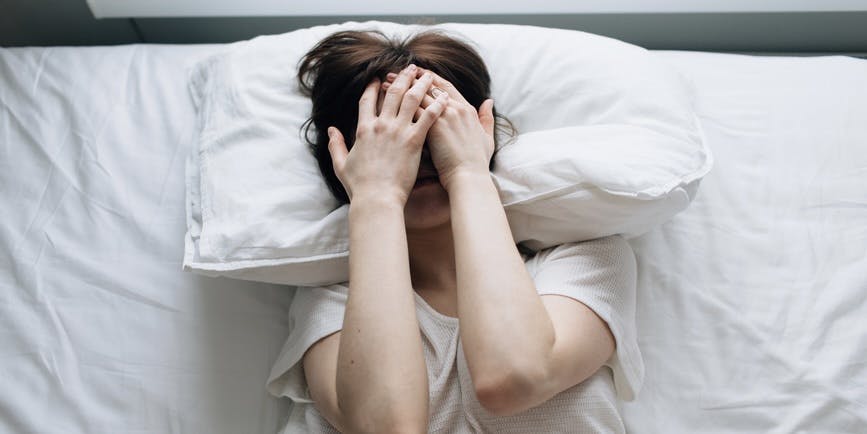
Bacterial vaginosis: causes, symptoms and treatment

Key Points:
- Bacterial vaginosis (BV) is a common bacterial infection. It’s caused by an imbalance of good and bad bacteria in the vagina.
- Common symptoms of BV include a strong vaginal smell and thin white discharge. But it does not always include symptoms, so some people may not know they have it.
- Dr. B can help you get BV antibiotics online through an online health assessment. We’ll connect you with a medical provider. They’ll discuss your symptoms and make sure you get the right BV treatment.
The words fishy and vagina should never go together. But every year, millions of people deal with the foul vaginal odor and unpleasant discharge associated with bacterial vaginosis (BV).
Untreated BV is linked to fertility problems. BV can also increase your risk of getting a sexually transmitted infection (STI). So it’s important to get the right BV medicine even if you have mild symptoms.
Read on for everything you need to know about the causes and symptoms of BV. Plus, how to get a BV prescription online through Dr. B’s health platform.
What is bacterial vaginosis?
Bacterial vaginosis is a condition where the natural balance of good and bad bacteria in the vagina gets thrown off. It’s the most common vaginal issue in people with vaginas ages 15-44, affecting about 30% of such people at least once during their lifetime.
A healthy vagina usually has a large number of bacteria (Lactobacillus) that protect the vagina from other infections. When there aren’t enough Lactobacillus in the vagina, other kinds of harmful bacteria can spread and grow. The most common bacteria to cause bacterial vaginosis is Gardnerella vaginalis.
What causes bacterial vaginosis?
Scientists aren’t entirely sure what causes an imbalance of bacteria in the vagina. But cases of BV are more common in people who:
- Have multiple sex partners
- Have a new sex partner
- Have unprotected sex
- Douche or use other irritating vaginal products
- Smoke
- Were assigned female at birth (AFAB) and have sex with other AFAB people
You cannot get BV from sharing bedding or toilet seats or from swimming pools or hot tubs.
BV is most common in people who are sexually active. But BV is not an STI or sexually transmitted. It is possible to get BV without engaging in sexual activities!
What are common symptoms of bacterial vaginosis?
Over 80% of people with BV do not experience symptoms. Symptoms may also be very mild or may come and go. But the most common BV symptoms include:
- A thin white, gray, greenish or yellow discharge
- Vagina smells that include a strong fishy vaginal odor, which may get worse after sex
- Vaginal irritation including vaginal itching like itchy vaginal lips or an itchy vulva
- Burning with urination (peeing)
Is it bacterial vaginosis or…?
Some symptoms are common across bacterial vaginosis and urinary tract infections (UTIs), STIs and yeast infections. The only way to know which infection you have is to talk to a medical provider. But these clues can suggest whether your symptoms might be from something other than BV.
- Yeast infections can cause a thick, cottage-cheese type of vaginal discharge. The discharge from bacterial vaginosis is usually thinner, like milk. You can get BV and a yeast infection at the same time. So talk to your medical provider about your symptoms.
- Chlamydia can also cause discharge. But it is usually lighter and may be transparent.
- Urinary tract infections often cause burning with urination (peeing). This can also happen with BV—so BV can feel like a UTI. UTIs rarely include any kind of vaginal discharge.
You can have BV and a UTI or other condition at the same time. A medical provider can tell you how to treat BV and UTI together.
What treatments are there for bacterial vaginosis?
Bacterial vaginosis is treated with a course of antibiotics. Medications may come as a cream or gel that you put in the vagina. Other options include BV pills that you take by mouth or granules that you sprinkle over soft food and eat.
The most common medications used to treat infections of BV are Metronidazole and Clindamycin. Other options include Tinidazole and Secnidazole.
- Clindamycin. Also available as Cleocin and Clindesse, this cream is put into the vagina. It can make latex condoms less effective. So be careful while on this medication and for up to three days after BV treatment ends.
- Metronidazole. Also available as Flagyl and Metrogel-Vaginal, this antibiotic treatment comes as a vaginal gel and a pill that you swallow. It can cause stomach upset and abdominal pain or nausea. So do not drink alcohol while using this medication and for three days after finishing it.
- Tinidazole. Aso available as Tindamax, this medication comes as an oral tablet. Avoid drinking alcohol while using this medication and for three days after finishing treatment.
- Secnidazole. Also available as Solosec, this one-dose medication comes as granules that you sprinkle over soft food. You should not drink alcohol while taking this medicine and for two days after finishing it. Also, you shouldn’t breastfeed for up to four days after finishing this medicine.
There are no over-the-counter medications for BV. Some over-the-counter medications—like those used for yeast infections—can actually make BV worse. So don’t try to cure BV at home without talking to a medical provider. You can start to treat BV online with a health assessment from Dr. B.
Should you treat BV if you don’t have symptoms?
There are good arguments for and against treating bacterial vaginosis if you don’t have symptoms.
Some research suggests that asymptomatic BV can get better on its own—so there’s no need to use antibiotics. The CDC currently does not recommend treating bacterial vaginosis in people who do not have symptoms. (Except in certain circumstances.)
Other researchers claim that BV increases the risks of STIs, miscarriage and infertility. So they believe every case should be treated.
Alternatives to antibiotics for bacterial vaginosis
BV comes back in more than 50% of cases—even after successful treatment. A second round of antibiotics is often then prescribed. Given the side effects and high recurrence rate, researchers are exploring non-antibiotic options. These include:
- Bacteria transplants from a healthy vagina.
- Probiotic supplements (available now) which may increase “good” bacteria.
- Boric acid suppositories. These have antibacterial and antifungal properties. They may also help regulate the pH level of the vagina. Early research shows they might be useful when combined with other treatments like prescription BV medications.
Vaginal tissue is very sensitive. So it may be harmful to use an alternative treatment without talking to a medical provider. These products aren’t regulated by the FDA and could be dangerous. And they aren’t safe for every situation—including pregnant women and others who can become pregnant.
How do you prevent bacterial vaginosis?
There is no foolproof way to prevent bacterial vaginosis. This can make the condition frustrating for those prone to recurrent BV. But there are steps you can take to encourage vaginal health and reduce your risk.
Here are a few activities to avoid that will prevent BV from coming back:
- Do not douche or use other potentially irritating products in the vagina. This includes sprays, deodorants, scented tampons and pads used during your menstrual cycle.
- Practice good hygiene. To keep your vagina clean, wipe your genital area thoroughly after using the bathroom and wash sex toys after using them.
- Limit the number of sex partners you have.
- Practice safe sex. Use birth control like latex condoms and dental dams.
- Wear cotton underwear. Cotton can wick away the moisture that may increase bacterial growth.
- Don’t smoke, since smoking affects the immune system.
Can probiotics prevent bacterial vaginosis?
There is no clear scientific consensus about whether probiotic-rich foods like yogurt or supplements can prevent BV. And the dose and type of bacteria strain might impact how well a probiotic supplement works. Some research shows that probiotics with multiple types of bacteria are more effective.
If you decide to try probiotic supplements, talk to your medical provider. They’ll help you identify a brand that works best for you.
Online treatment for bacterial vaginosis
If you experience bacterial vaginosis symptoms, several BV prescription medications can help clear things up. And you can get these BV meds online with a Dr. B health assessment.
Just share your symptoms and medical history. A licensed provider will then take you through bacterial vaginosis prescription options. If appropriate, they’ll send your BV pill or other medication to the local pharmacy of your choice. Get started here.
Sources:
Abou Chacra, L., et al. (2022). Bacterial vaginosis: what do we currently know?. Frontiers in Cellular and Infection Microbiology.
Amata, R., et al. (2013). Urinary tract infection in vaginitis: a condition often overlooked. Nepal Medical College Journal.
American Society of Health-System Pharmacists, Inc.. (2023). Tinidazole.
American Society of Health-System Pharmacists, Inc. (2023). Metronidazole Vaginal.
American Society of Health-System Pharmacists, Inc. (2023). Secnidazole.
Bautista, C.T., et al. (2016). Bacterial vaginosis: a synthesis of the literature on etiology, prevalence, risk factors, and relationship with chlamydia and gonorrhea infections. Military Medical Research.
Centers for Disease Control and Prevention. (2022). Bacterial vaginosis - CDC basic fact sheet.
Centers for Disease Control and Prevention. (2021). Bacterial vaginosis - STI treatment guidelines.
Chen, R., et al. (2022). Probiotics are a good choice for the treatment of bacterial vaginosis: a meta-analysis of randomized controlled trial. Reproductive Health.
Goje, O. (2021). Bacterial vaginosis (BV) - gynecology and obstetrics. Merck Manuals Professional Edition.
Joseph, R. J., et al. (2021). Finding a balance in the vaginal microbiome: how do we treat and prevent the occurrence of bacterial vaginosis?. Antibiotics.
Koumans, E.H., et al. (2007). The prevalence of bacterial vaginosis in the United States, 2001-2004; associations with symptoms, sexual behaviors, and reproductive health. Sexually Transmitted Diseases.
Leitich, H., et al. (2003). Bacterial vaginosis as a risk factor for preterm delivery: a meta-analysis. American Journal of Obstetrics and Gynecology.
Muzny, C. A., et al. (2020). Asymptomatic bacterial vaginosis: to treat or not to treat?. Current Infectious Disease Reports.
Nelson, T. M., et al. (2018). Cigarette smoking is associated with an altered vaginal tract metabolomic profile. Scientific Reports.
Planned Parenthood. What is bacterial vaginosis? Symptoms, signs and causes.
Ravel, J., et al. (2021). Bacterial vaginosis and its association with infertility, endometritis, and pelvic inflammatory disease. American Journal of Obstetrics and Gynecology.
Surapaneni, S., et al. (2021). Recurrent bacterial vaginosis: an unmet therapeutic challenge. Experience with a combination pharmacotherapy long-term suppressive regimen. Sexually Transmitted Diseases.
Valenti, P., et al. (2018). Role of Lactobacilli and Lactoferrin in the mucosal cervicovaginal defense. Frontiers in Immunology.
Webb, L. (2021). Probiotics for preventing recurrent bacterial vaginosis. Journal of the American Academy of PAs.
Wu, H., et al. (2021). Potential benefits of probiotics and prebiotics for coronary heart disease and stroke. Nutrients.
Sign up for the free Dr. B newsletter for a weekly report on the latest in healthcare + research-based advice for staying healthy and mentally well.
Related articles







